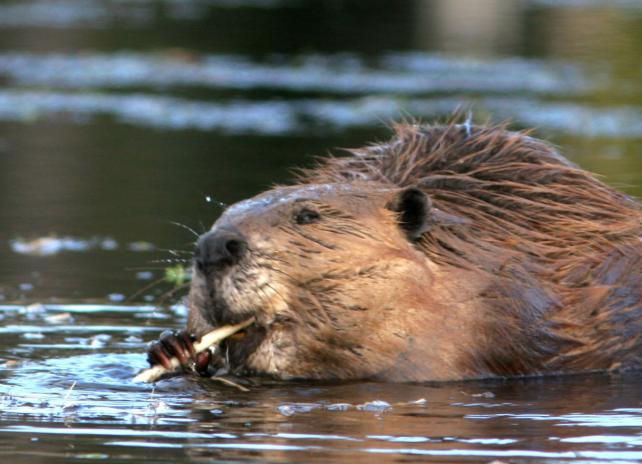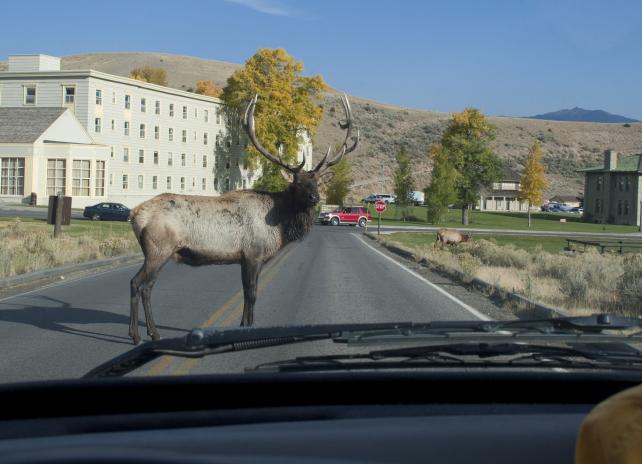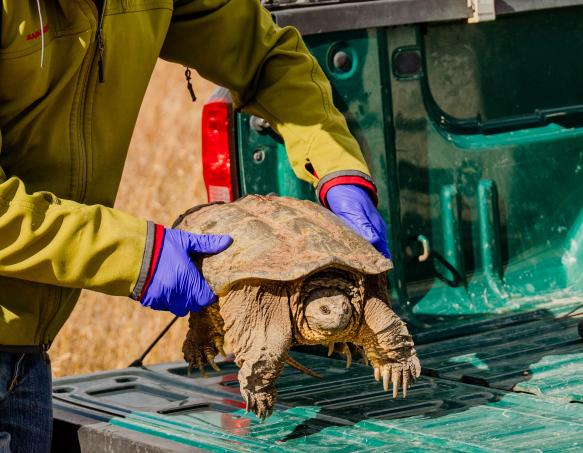
Urban & Nuisance Wildlife
When wildlife and humans live in the same place, there is potential for conflict. Several species have adapted to urban and suburban areas and can be quite common in residential developments. As cities in Wyoming continue to grow, residential development around the periphery impacts wildlife habitat and displaces animals. It also creates the potential for additional conflict.
In some cases, the conflicts come from animals just trying to continue living in the locations where these developments occur. In other cases, residential development offers things that are attractive, such as lush vegetation, unsecured garbage, denning and nesting sites, and domestic animals that can be attractive prey. Although for the most part, wildlife and humans can coexist, conflicts do arise.
Prevent Conflicts with Different Groups of Different Groups of Wildlife
Habitat Management
Planting landscaping plants that are not attractive (not palatable) helps reduce damage from wildlife. Lists of species that are unattractive to wildlife can be obtained from nurseries, county extension agents, the Wyoming Game and Fish Department, and on the Internet.
Exclusion
Plant covers and protective netting on plants is a good way to protect them. Fencing is an effective technique; various fence designs can be used. Depending on the number of plants to be protected and the planting arrangement, they can be fenced individually, or collectively. The best fence type (barbed wire, mesh) will depend on the situation. Fencing is often the only means to protect young trees and shrubs from males rubbing their antlers at the end of the velvet period or during the rut.
Repellents
A variety of products can be used to protect plants from being eaten. Repellents such as Repel®, Scare Away® and Deer Away® can be purchased from nurseries, feed stores, or catalog and Internet suppliers. A repellent can be made using Tabasco® or other hot sauce diluted in water, then sprayed with a spray bottle on plants. Deer can sometimes be repelled with handfuls of human hair (from barber shops or beauty salons) in 6- 8 inch ‘bags’ made from sections of women's nylon hose and hung 24-36 inches above the ground at approximately 3-foot intervals. Repellents are temporary and will have to be renewed periodically. Exposure to the sun slowly degrades them, and precipitation will wash them away.
Frightening
Scarecrows and effigies may repel deer under certain circumstances, especially if they are moving. Motion-activated lights may also protect areas from these animals. Mylar streamers, mylar strips twisted a few times and strung between poles like single-strand fencing, pinwheels, and disposable aluminum pie plates dangling from the string are other methods to frighten animals. The Contech motion-activated sprinkler is a sprinkler pest chaser that can also be effective. Search on the Internet for "sprinkler pest chaser.”
Small mammals - Cottontail rabbit, fox, squirrel, skunk and bats
The best preventive action for these species is to remove or secure attractants and eliminate denning sites.
Exclusion
Fencing is an effective technique for permanently protecting plants that cottontail rabbits may damage. The trunks of young trees can be wrapped with a special protectant material or a loose wrap of mesh fencing. Mothballs, crystals, or ammonia-soaked rags can repel and temporarily exclude foxes, squirrels and skunks, especially from dens in undesirable locations. Permanent exclusion is the preferred solution.
Repellents
The use of Thiram based repellents is registered for the use on inedible plants that are inedible for humans. Some suppliers, especially those specializing in trapping materials, offer coyote urine and other furbearer attractants, which can be effective repellents for prey species (rabbit, squirrel). See the discussion under Big Game (above) for other suggestions.
Frightening
Noise devices may scare these animals from specific areas, but they can be annoying to the homeowner and neighbors. See the discussion under Big Game (above) for visual deterrents.
Trapping
Live trapping can be used to relocate an animal to a new area. Live traps may be borrowed from the WY Game, Fish Department, and Cheyenne Metro Animal Control.
Squirrels
Problems specific to fox squirrels are primarily related to them becoming pests at bird feeders and nesting in attics or other house spaces.
Feeders - Use feeders specifically designed to exclude squirrels or hang the feeders so they are unreachable by them.
Nests in problem areas - Outside of the nesting/young-rearing period, plug openings to attics, soffits and other places where they can enter.
Bats
If there is a problem dealing with bats, contact the Wyoming Game and Fish Department Nongame Program at the Lander Regional Office 307-332-2688.
Predatory Animals
If there is a problem with a predatory species (coyote, skunk, raccoon, etc.) in Cheyenne, contact Animal Control (635-1453).
However, they will not respond to badger or bobcat calls. Contact the WY Game and Fish Department (777-4600) for these species. Badgers are common but seldom noticed occupants of prairie habitats. Badgers are not aggressive unless harassed or cornered; they will not on their attack pets or children. Left alone, a badger can help control ground squirrels and will eventually leave to cruise the rest of its large home range. Badgers can be killed if they are causing damage (notify the Game Warden if necessary). However, live trapping and relocation are preferred.
Protected Birds
Raptors
Swainson hawks and red-tailed hawks often nest in urban and suburban areas with large trees. The adults can be very aggressive during the nesting period when they are defending their nest and nestlings. Adult birds may stoop on people and pets when approaching the nest tree. This aggression only occurs during a short period, so patience and avoiding the vicinity of the nest are the best alternatives.
Contact the Wyoming Game and Fish Department: 777-4600
Waterfowl and Other Aquatic Birds
Most urban concerns occur during the nesting season. Hen mallards often nest under shrubbery in residential areas near water in urban areas. This is not unusual because mallards nest away from water, not along the shoreline, in natural settings, to avoid nest predators. When the young hatch it's best not to disturb the hens because they will abandon the nest. If a hen is in the process of building the nest and it is in an undesirable location, attempt to disrupt the construction to discourage continued nest building. If the nest has been constructed and the hen is incubating the eggs, the best approach is to avoid the vicinity until the eggs hatch. All eggs will hatch during a very short period, and then soon after, the hen will move the chicks to water. This may involve a long march through a residential area to a city lake or pond.
Exclusion
Fencing acts like an artificial vegetation barrier. Fences need to be only 18 inches tall.
Repellents
Methyl anthranilate can be used as a repellent that irritates when they come into contact with it.
Frightening
Scarecrows, effigies, homemade plastic flags, Mylar streamers and other deterrents that move in a breeze can sometimes be highly effective.
Managing Human-Goose Conflicts in Urban, Suburban and Agricultural Areas
Canada geese reside year-round locally throughout much of Wyoming, and large numbers of migrant Canada geese occupy parts of Wyoming during the fall and winter. Canada geese provide valuable hunting and viewing opportunities, but, in urban and suburban areas, local concentrations of geese can lead to conflicts between geese and people. During established hunting seasons, the disturbance associated with hunting activity effectiveway reduces goose use of specific locations. In suburban and urban areas, however, hunting is usually not an option, and Canadian geese often create problems during the spring and summer. In these situations, the alternative approaches summarized below can be helpful.
Canada Geese are Protected by Federal and State Laws
Non-lethal control activities (e.g., activities in which there is no direct contact with geese and that do not result in harm to geese, goslings, eggs, or nests) do not require federal permits (do check state regulations and local ordinances), and most non-lethal activities can be conducted throughout the year. Any actions that result in handling, damage, or destruction of geese, or their eggs or nests, require permits from Wyoming Game and Fish Department. The primary control activity conducted under available permits is egg and nest control of locally-breeding geese. This activity is usually performed following, and in conjunction with, non-lethal control methods.
Egg and Nest Control Activities
The Wyoming Game and Fish Department (WGFD) has been issued a special statewide permit by the U.S. Fish and Wildlife Service. This permit allows the WGFD to destroy eggs and nests of breeding Canada geese. In most cases, eggs are 'oiled'-100% corn oil (a substance exempted from regulation by the U.S. Environmental Protection Agency) is applied to eggs in the nest; the oil prevents the eggs from developing and hatching. The WGFD allows landowners and land managers to conduct egg control activities under the statewide permit and provides guidance and technical assistance to sub-permittees.
Written permission from the Wyoming Game and Fish Department is required before any interference with eggs or nests can begin (contact the permitting office) for more information about applying for a federal permit to conduct egg or nest control activities.
Habitat Alteration
Stop Feeding
Do not feed or allow the feeding of geese or other waterfowl on your property. Efforts to frighten geese away can be thwarted if nearby neighbors are feeding the geese. If geese are being fed in the area/ it won't be easy to persuade them to move elsewhere. Landscape Modification
Geese dislike visual barriers between ponds and feeding areas. Planting trees, thick bushes, or a dense hedge between grassy areas and water may make your property less attractive to geese. While the living barriers growing thick enough to be useful, you may need to use other methods, such as temporary fencing or repellents, to keep the geese from establishing in the area. Geese prefer mowed grasses; so leaving a buffer area of tall grass and wildflowers can create a visual and physical barrier to resident geese.
Exclusion and Barriers
Some people successfully place physical barriers, such as fences and boulders, to prevent geese from entering an area. The fence should be at least two feet high and have openings no larger than three-by-three inches. Chain link, chicken wire, construction fences, and wood can be used. Where appropriate, electrical fencing can provide a harmless but effective shock to discourage geese from entering an area; check with your local authorities to see if there are safety restrictions on electrical fencing.
Repellents
There are several commercial repellents advertised to keep geese off of lawns. These products must be applied according to label directions to be effective; they may need to be reapplied after rain1 or twice weekly in dry conditions. Approved repellents are made from biodegradable, food-grade ingredients and are not toxic to birds, dogs, cats, or humans.
Hazing Methods
General
A permit is not required to scare repel, or herd geese to protect your property, as long as the birds are not killed or harmed. Hazing geese can involve vigorously chasing geese with a broom or water hose. Repeated hazing can cause geese to relocate, but you must begin again if geese return. Hazing is most effective when geese first arrive at a location.
Trained Dogs
Some landowners and land managers have used highly trained herding dogs with skilled handlers to chase geese off their properties. This is not a method to be tried with a canine pet-dogs that cannot be allowed to harm geese or other waterfowl. Check with a game warden or stop by a WGFD regional office for guidance before using dogs to chase geese. Leash laws in most cities and towns do not allow dogs to run free to chase geese. However, where qualified and used consistently, this method has proven successful in persuading geese to avoid local sites.
Noisemakers and Pyrotechnics
Check with local authorities before starting noise making, but loud and surprising noises can deter resident geese. Where allowed, 12-gauge 'cracker shells' and other sharp, percussive sounds can prompt geese to move to another, more peaceful location. Be sure to let neighbors know in advance of noise-making plans.
Scarecrows, Balloons, Scare Tape
As a short-term tactic, often used with other methods, geese can sometimes be scared away using various shapes and movements. Scare tape is thin, shiny ribbon, usually silver on one side and red on the other. Place the reflective tape where it is visible to the geese and make a low fence across the area where you don't want geese to cross. Tie short lengths of the shiny ribbon on the cross tape-the flashing and rattling of the tape can frighten geese. People, pets, and wind can break the tape, so it needs to be inspected and repaired daily to be useful.
Swans
Some locations have acquired swans (with clipped wings so they cannot fly) and released them on a pond or lake to frighten away geese. This method is not recommended where the swans will come in regular contact with people, as they can be aggressive to humans as well as geese. Check local laws to be sure swans are allowed in your area. Be aware that swans can also breed, and care must be taken to ensure you don't create an overpopulation of swans instead!
Hunting
Hunting Canadian geese remains a cost-effective way to manage goose populations in non-urban areas where firearm discharge is allowed. Hunters who purchase state licenses and federal waterfowl stamps contribute to the costs associated with hunting waterfowl and help reduce overpopulation of Canada geese.
Conclusion
In summary, if you want to discourage Canada geese, respond quickly, stay persistent, and try to use multiple methods at a time. If feeding is occurring in the immediate area, all other methods to discourage geese may be of little use. Be certain to check local ordinances and obtain any necessary state or local permits (as outlined above) before beginning any control measures.
Other Birds
Flickers, which are commonly mistaken for woodpeckers, "drum" on wood sided houses and other good sounding structures during territorial establishment and nesting. These large brownish birds with an orange tint under the wings and tail appear to be drilling for insects when they do their territorial drumming. But, drumming is actually analogous to the male territorial song of other species during the nesting season. The males will usually use up to several drumming sites around their territories and can cause localized damage in wood siding. Occasionally, they will attempt to create nesting cavities in the side of a house. Territorial drumming usually lasts only a couple of weeks, and if birds can be discouraged from using the drumming sites they have selected during this period, the problem will go away once the adults have started rearing their nestlings.
- Some common ways to deal with this problem are to hang Mylar ribbons, pinwheels, aluminum pie plates or any brightly colored object at the drumming site. This works because the fluttering frightens the birds away.
- Owl decoys can be used a deterrent as well. They can be obtained from a feed store, sporting goods catalog, or online.
- Heavy mesh screen (hardware cloth) can be hung temporarily with staples or nails over the area where a flicker is drumming to discourage it and preclude further damage. Cover a large enough area so the bird doesn't just move over to an adjacent area that is not protected by the mesh screen.
Bird Nests
Nest construction in undesirable places can be discouraged earl y in the nest-building period by removing the nesting materials at the nest site. The birds may be persistent once they’ve decided that location is desirable, which means nesting material may have to be removed as often as daily until they are discouraged. Swallow, robin and other nests constructed wholly or partially of mud can be removed with a hose, a broom or a shovel. Exclusion is often the best method. This entails placing something at the site that makes it unusable. Swallows often nest under the eves of houses and outbuildings. Hardware cloth or chicken wire hung loosely down from the soffit just out from the corner of the wall and the soffit during the nest building period precludes the birds from building their nests.
Nestlings on the Ground
Sometimes nestlings fall from the nest prematurely, however this is rare. More commonly, as they are ready to fledge and begin to learn to fly, they will leave the nest and can be found on the ground or in low shrubbery. This period is part of the fledging process. The adults are usually close by continuing to tend them by bringing them food and protecting them from disturbance as they learn to fly and build the strength to do it. Placing them back in the nest, if it can be found, will just result in them leaving it again. The best approach is to leave them alone, or to place them someplace secure nearby where the adults can find them by the young's calls. Pets, especially cats, should be kept away or inside for a few days until the young bird is capable of strong flight.

Homeowner's Guide to Resolving Wildlife Conflicts
The Wyoming Game and Fish Department also has a Technical Bulletin which provides further suggestions for resolving conflict with urban and nuisance wildlife.

